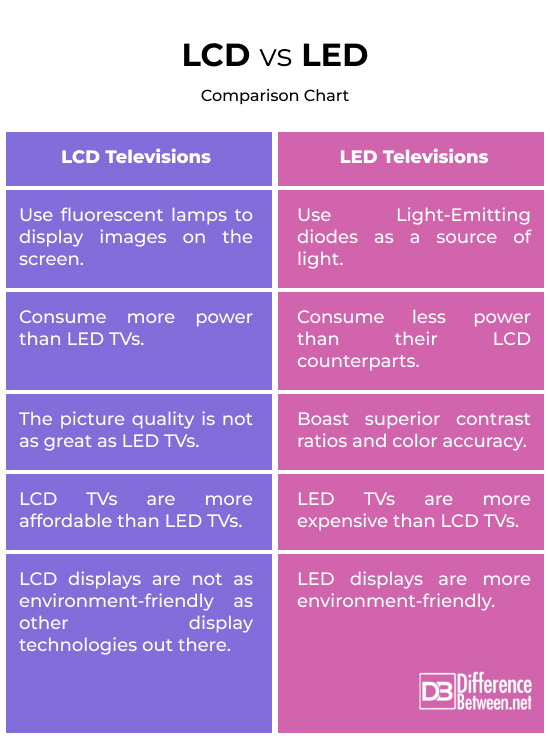Difference Between LCD and LED Televisions
In the past few decades, there has been a significant advancement in the technology of television. The introduction of high-definition television has fundamentally altered the way in which we watch television, after years of essentially utilizing the identical technology. LED and liquid crystal display televisions are the most recent iteration of this transition.
The best televisions that money can buy nowadays are those that have an LCD or LED display. However, what differentiates them from one another?
Here, we will examine the fundamental distinctions that exist between the two technologies that are used for television (also known as display technologies).

What is LCD technology?
LCD stands for liquid crystal display, which is a type of flat-screen display technology that use liquid crystals to exert control over light and generate images on the screen. This technology is currently the most widely used form of television technology, and its sizes range from less than one inch to more than one hundred inches.
Each pixel on the screen is composed of three sub-pixels, which are commonly colored red, green, and blue. The tiny pixels that make up the screen are called pixels. A light source, which is typically a fluorescent lamp or an LED (Light-Emitting Diode), is located behind the liquid crystal display (LCD) panel. As it travels through the liquid crystals, this backlight is reflected.
The amount of light that is able to flow through the liquid crystals is controlled by the twisting that occurs when an electric current is applied to the crystals. The hues and tones that appear on the screen are the result of this.
Changing the intensity of the red, green, and blue sub-pixels that are contained within each pixel allows for the creation of a broad variety of colors. The whole spectrum that can be seen by the human eye is formed by the combination of these hues.

What is LED technology?
LED display technology is a flat panel display technology that use LEDs for backlighting. LEDs are also known as light-emitting diodes. Although light-emitting diodes (LEDs) have been around for quite some time, to now they have never been utilized in television displays.
Essentially, LEDs are types of lights. LED televisions, on the other hand, do not employ LEDs for each and every pixel that appears on the screen. Instead of using CCFLs (Cold Cathode Fluorescent Lamps), which are the most common type of backlight source in LCD televisions today, LEDs are used as a backlight source in these televisions. This allows the light to be produced beneath the screen.
Displays that are edge-lit and direct-lit are the two primary types of LED televisions that are available. LEDs that are edge-lit have a small profile and are very efficient in terms of energy consumption, but LEDs that are directly illuminated provide a consistent brightness across the panel.
When compared to its LCD equivalents, LED televisions have considerably higher contrast ratios and more accurate color reproduction. They consume less power as well, up to forty percent less.
Difference between LCD and LED Televisions
Backlight Technology
LCD televisions use liquid crystals to manipulate light and produce images on the screen. LED televisions, on the other hand, use Light-Emitting Diodes (LEDs) for backlighting. Unlike LCD TVs, LED televisions use LEDs to create the light behind the screen.
Picture Quality
When it comes to picture quality, both LCD and LED televisions deliver sharp images with high resolution and dynamic contrast ratios. However, LED technology typically offers a slight edge in terms of color depth and brightness levels. They boast superior contrast ratios and color accuracy compared to their LCD counterparts.
Energy Efficiency
CCFLs in traditional LCD TVs consume more power, which may result in higher energy consumption. LED televisions are more energy-efficient and consume significantly less power than their LCD counterparts. The Light-Emitting diodes precisely control brightness levels and contribute to lower power consumption.
Viewing Experience
The viewing experience is greatly influenced by brightness levels and color accuracy. LED televisions exhibit brighter displays with enhanced color reproduction to create immersive viewing experiences. This results in deeper blacks and improved picture quality. LED TVs also have higher refresh and rendering rates for sharper images.
LCD vs. LED: Comparison Chart

Summary
The difference lies in the underlying display technologies and performance metrics. While LCD TVs are budget-friendly, LED TVs offer superior picture quality and energy efficiency. If you’re looking for a budget-friendly alternative, LCD televisions are a great option. On the other hand, those who prioritize picture quality and energy efficiency may opt for LED televisions.
FAQs
Which is better, LED TV or LCD TV?
LED televisions are generally considered better because of their sleeker design profiles, improved energy efficiency, and superior picture quality.
Which is better, LED screen or the LCD screen?
LED screens boast higher resolutions and better contrast ratios than their LCD counterparts. From black levels to color accuracy, LED screens certainly have an edge.
Can you tell the difference between LCD and LED TV?
Yes, the main difference lies in the backlighting technology. LCD televisions use CCFLs or LEDs for backlighting, while LED televisions use Light-Emitting Diodes (LEDs).
Which is better for your eyes, LED or LCD?
LED displays typically emit less heat compared to traditional LCDs, which makes them a slightly better alternative.
What are the disadvantages of LED screen?
Some downsides of LED displays include:
- Limited viewing angles
- More expensive than their counterparts
- Higher power consumption
Which lasts longer, LCD or LED?
Thanks to the LED backlighting technology, which is more durable and less prone to dimming over time, LED TVs typically have a longer lifespan than traditional LCD TVs.
What is the biggest disadvantage of an LCD screen?
One biggest downside is their limited viewing angles. Colors and brightness may distort when viewed from extreme angles.
What are the disadvantages of LCD TV?
Disadvantages of LCD televisions are:
- Lower contrast ratios
- Limited viewing angle and brightness
- Difficulty producing black and very dark grays
Which is better, LCD, LED, or OLED?
OLED is surely the winner when it comes to overall picture quality. OLED displays provide superior contrast ratios and color accuracy. However, they have a relatively shorter life span compared to LCD and LED televisions. LCD and LED displays, on the other hand, can go brighter than OLED displays.
- Difference Between Caucus and Primary - June 18, 2024
- Difference Between PPO and POS - May 30, 2024
- Difference Between RFID and NFC - May 28, 2024
Search DifferenceBetween.net :
Leave a Response
References :
[0]Lee, Jiun-Haw, et al. Introduction to Flat Panel Displays. John Wiley & Sons, 2008.
[1]Gross, Benjamin. The TVs of Tomorrow: How RCA’s Flat-Screen Dreams Led to the First LCDs. University of Chicago Press, 2018.
[2]Chen, Robert H. Liquid Crystal Displays: Fundamental Physics and Technology. John Wiley & Sons, 2011.
[3]Lance, Paul. Just Tell Me How It Works: Practical Help for Adults on All-Things-Digital. Grandview Press, 2014.
[4]Image credit: https://www.canva.com/photos/MAEJGo-3nEA-lcd-tvs/
[5]Image credit: https://www.canva.com/photos/MAFDGidnFuY-black-led-tv-television-screen-mockup-landscape-on-monitor/
